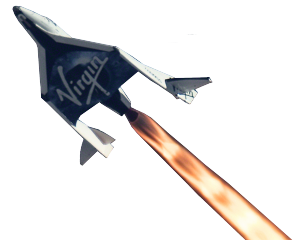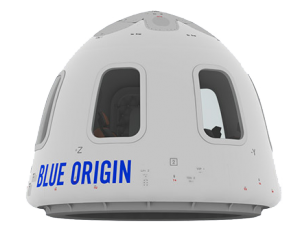
Suborbital Noctilucent Cloud Tomography
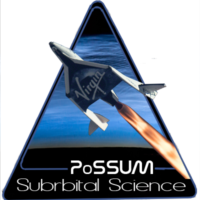
The PoSSUM Noctilucent Cloud Tomography Experiment seeks to:
1. Employ noctilucent cloud and OH-layer imaging and tomography to characterize the roles of gravity wave and instability dynamics in the mixing and transport processes of the upper atmosphere.
2. Characterize the geometry of noctilucent cloud particles to better understand their growth and sublimation processes.
Gravity Wave and Instability Dynamics
The PoSSUMCam system will be used to obtain high-resolution imagery of noctilucent clouds microfeatures as the spacecraft passes through the cloud layer, much like an MRI creates 3D representations of the human body. These images will be used to build extremely high-resolution models of the small-scale structures of noctilucent cloud layers through modeling algorithms developed for the program. These structures have been difficult to resolve from previous means of observation from space-based or ground-based imagers but are believed to contain most of the information pertaining to energy and momentum deposition in the upper atmosphere.
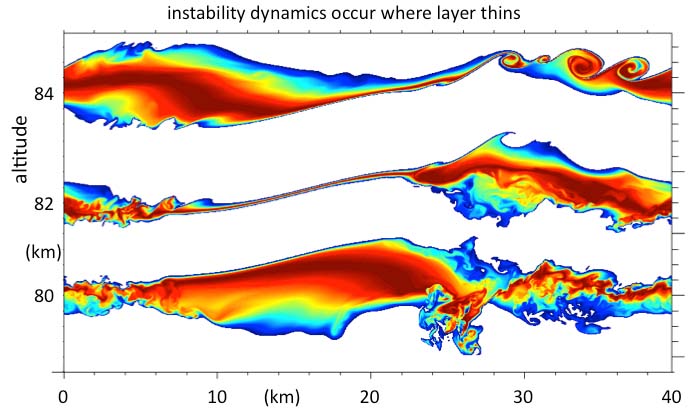
Campaign Plan
Each PoSSUM Tomography Experiment sortie will employ a manned reusable suborbital vehicle from a high-latitude spaceport. Project PoSSUM noctilucent cloud campaigns require launches from latitudes where noctilucent clouds could be observed, since noctilucent clouds form generally at latitudes higher than 60 degrees. The clouds also form with greater intensity at higher latitudes. PoSSUM noctilucent cloud campaigns are planned from Spaceport Sweden, which is located in northern Sweden at a latitude of 68 degrees, and Eielson AFB, near Fairbanks Alaska.
.
When strong cloud formations are observed from the ground or from LiDAR, the spacecraft will be launched to an altitude that transitions the noctilucent cloud layer. The clouds will be under direct illumination from the sun and the attitude of the spacecraft would be oriented north to the presumed region of highest cloud density. Launch opportunities could not be guaranteed on any specific night as there is no way to predict on what days the noctilucent clouds will be present. However, historical trends indicate one good opportunity every five days. A ‘Commit to Launch’ decision will be made when strong cloud formations are observed from local ground-based LiDAR.
Commercial Manned Reusable Suborbital Vehicles (rSLVs)
Commercial Reusable Manned Suborbital Vehicles offer an unprecedented capability to conduct aeronomy research, and Project PoSSUM is currently working with two suborbital vehicle providers: Virgin Galactic and Blue Origin.
Advantages of Using Manned Reusable Suborbital Vehicles
- Suborbital vehicles are stabilized, enabling sustained stabilized imagery of noctilucent cloud layers and other features of the upper atmosphere.
- The rapid re-usability of suborbital spacecraft enable numerous sequential observations within a campaign season so that variations within a season may be observed.
- The operator will enable the tracking of specific microfeatures (e.g. instability dynamics and turbulence) and assure optimal positioning of the imagers.
- The operator will also be able to monitor the state of health of the payloads, reducing overall mission risk.
- There are substantial cost savings over sounding rocket campaigns.
PoSSUM Instrumentation
Instrumentation for baseline PoSSUM sorties include the operator-tended PoSSUMCam imager system, the Mesospheric Aerosol Sampling Spectrometer (MASS), and the Mesosphere Clear Air Turbulence (MCAT) system and the PoSSUM Atmospheric Sampler. PoSSUM Instrumentation was initially designed for flight on the XCOR Lynx but has since been redesigned for flight on Virgin Galactic’s Spaceship Two and the Blue Origin New Shepard vehicles.
PoSSUMCam: Light-weight, robust, and flight proven
The PoSSUMCam System is an operator-controlled multi-instrument interface that controls an HD video camera system, the WFI wide-image camera, a 1200nm infrared camera, the MASS and MCAT instruments, and an atmospheric sampler. The video camera system will investigate noctilucent cloud small-scale structures, the still-frame camera will capture the cloud structure as a whole, and the infrared camera will investigate the correlation of structures in the OH layer that reside above noctilucent cloud layers. A patented and simplified operator interface allows complete operation of all cameras considering the limited dexterity available to an operator in a spacesuit. PoSSUMCam can support a variety of visible and infrared cameras and serves as a simplified interface so that the PoSSUM Scientist-Astronaut can control all critical aspects of science data acquisition during a suborbital flight.
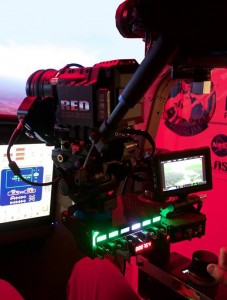
PoSSUM Atmospheric Sampling Instruments
Mesospheric Atmospheric Sampling Spectrometer (MASS)
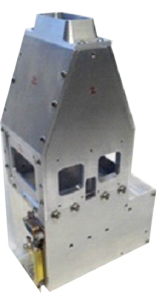
The MASS payload mounts to the spacecraft in an external pod. An electrostatic mass analyzer, MASS performs a mass-analysis to determine the concentration of both positively and negatively charged aerosol particles in the atmosphere. This informs us of the nature of both terrestrial and extra-terrestrial (e.g. meteorite) particulates, which is essential in understanding how noctilucent clouds nucleate. Specifically, MASS will determine:
Mesospheric Clear Air Turbulence (MCAT)
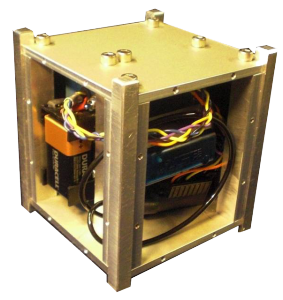
The MCAT system is an extremely sensitive pressure gauge coupled with an accelerometer to be mounted in an external pod of the spacecraft. The MCAT vacuum pressure gauge extends into the airflow to measure atmospheric densities from the ground to an altitude of 120 km, from which atmospheric temperatures may be calculated with a resolution of less than 100 meters. Combined with the vacuum pressure gauge is the MCAT micro-g accelerometer system, which measures the atmospheric drag on the vehicle, from which atmospheric densities of comparable resolution may also be calculated. By calculating the atmospheric density through two independent methods, greater precision and confidence are achieved.
Want to get involved?
Apply to the Advanced PoSSUM Academy or the PoSSUM Scientist-Astronaut Program!



